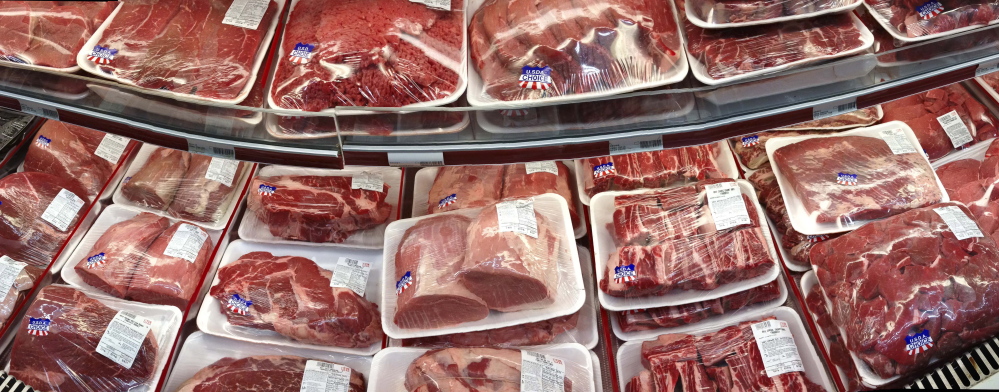WASHINGTON – For years, the government has told Americans to eat their vegetables. A rewrite of the government’s dietary guidelines could include some new advice, too, on sugar, salt, meat and caffeine.
Whether individuals listen or not, the dietary guidelines affect nutritional patterns throughout the country – from federally subsidized school lunches to labels on food packages to your doctor’s advice. They also form the basis for the government’s “My Plate” icon, which replaced the food pyramid a few years ago.
A government advisory committee made up of medical and nutrition experts is set to issue preliminary recommendations this month. It indicated in draft recommendations circulated in December that it may suggest some changes in current dietary advice.
The secretaries of the Agriculture and Health and Human Services Departments will take those recommendations into account as they craft the final 2015 guidelines, expected by the end of the year.
Five things to watch for as the government begins writing the new guidelines:
REAL LIMITS ON SUGAR
The 2010 dietary guidelines recommended generally reducing caloric intake from sugars added during food processing or preparation. Those added sugars act the same in the body as naturally occurring sugars, but generally add empty calories.
In its draft recommendations, this year’s advisory committee is suggesting specific limits on added sugars for the first time, advising that only 10 percent of calorie intake come from added sugars.
The committee said that currently, Americans get about 13 percent of their total calories from added sugar, or 268 calories a day. Much of that is from sugary drinks. Older children, adolescents and young adults get as much as 17 percent of their calories daily from added sugars.
The Food and Drug Administration proposed last year that the amount of added sugars be included as a line on nutrition facts labels on food packages.
HOW MUCH SALT IS TOO MUCH
Lowering sodium is important for heart health, and the 2010 dietary guidelines recommend that people eat less than 2,300 milligrams a day. That is reduced to 1,500 milligrams for people who are 51 and older, African-American or those who have hypertension, diabetes or chronic kidney disease. Those subgroups amount to about half of the population.
While the committee’s draft recommendations appear similar, it is unclear if their advice on sodium will be as strong as the 2010 guidelines. A 2013 report by the Institute of Medicine said that while lowering salt intake is important for health, there is no good evidence that eating less than 2,300 milligrams a day of sodium offers benefits.
The dietary guidelines advisory panel noted that years of public pressure to lower sodium levels has not had much effect. The average American consumes more than 3,400 mg of sodium a day, or about 1 ½ teaspoons.
EAT LESS MEAT?
Current guidelines advise that people eat lean meats as a healthy way to get protein, but the advisory panel has debated whether lean meats should be included.
In addition, the draft recommendation discussed at the panel’s Dec. 15 meeting says a healthy dietary pattern includes fewer “red and processed meats” than are currently consumed.
After that meeting, the National Cattlemen’s Beef Association sent out a statement by doctor and cattle producer Richard Thorpe calling the committee biased and the draft meat recommendations absurd. He said lean beef has a role in healthy diets. The American Meat Institute issued comments calling any attempt to take lean meat out of a healthy dietary pattern “stunning” and “arbitrary.”
NEW ADVICE ON CAFFEINE
The advisory committee indicated it may propose guidelines that would urge pregnant women to limit caffeine intake. The 2010 guidelines don’t address caffeine use.
The panel said it supports advice from medical organizations that pregnant women limit caffeine to less than 200 milligrams a day, or around two cups of coffee.
“Limited evidence suggests that moderate caffeine intake is associated with a small increased risk of miscarriage, stillbirth, low birth weight, and small for gestational age births,” the committee said in its draft recommendations.
ROLE OF THE ENVIRONMENT
Over the past year, the committee has discussed the idea of including sustainability as a dietary goal. The advisory panel said in its draft recommendations that there is “compatibility and overlap” between what is good for health and what is good for the environment.
The committee has framed the issue in terms of ensuring food access for future generations, and also what foods are healthiest.
Guidelines addressing the environment could be another blow for the meat industry. A diet higher in plant-based foods and lower in animal-based foods is “more health promoting and is associated with lesser environmental impact than is the current average U.S. diet,” the draft recommendations said.
Send questions/comments to the editors.


